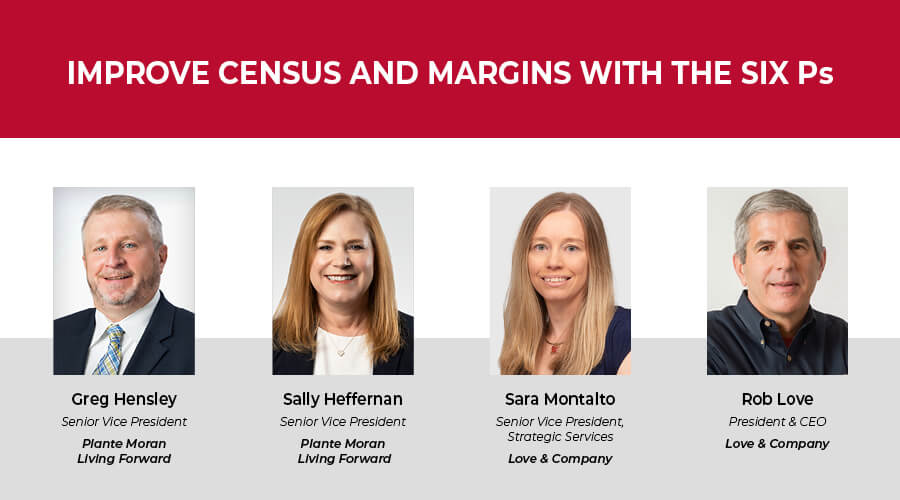Part II: How Planning, Promotion and Performance stimulate success in senior living.
As the baby boomer generation becomes dominant in senior living, the challenge for any community—old or new—is to be in step with what incoming residents want and need, and to help empower them to live their best, most productive lives.
This month, as part of our continuing webinar series, we team with Sally Heffernan and Greg Hensley of Plante Moran Living Forward (PMLF) to discuss Six Ps—key steps that can help maximize marketability and occupancy in today’s competitive senior housing market. The Six Ps are:
- Place (the external market)
- Product (physical plant and amenity and service offerings)
- Price (monthly service fees and entrance fees)
- Planning (financial strategy for phasing improvements and strengthening the organization for growth)
- Promotion (marketing and sales)
- Performance (operations)
In this, Part II of a two-part series, we look at Planning, Promotion and Performance to see why they’re important. (You can read Part I here.)
Planning
With today’s rapid increase of the affluent senior market, there are many opportunities for growth in senior living. However, the combination of higher construction costs and interest rates can make planning challenging.
Greg Hensley, senior vice president of PMLF, says, “It’s more likely now that projects will be completed in phases. Rolling out projects in phases can help a community stay financially fluid as it provides the owner with time to keep a close eye on operations. And while phasing certainly can increase the complexity of a project, there are ways to be smart about the process.
“In phased projects, it’s important to have a well-established, experienced team. Have an architect, a contractor and a marketing specialist on board from the start, and ensure that they’re all on top of their game and know how to keep the project moving. Then, be sure you complete the initial planning and programming before an architect gets started on actual drawings. There’s nothing worse than spending money on drawings only to discover that the project is not feasible, or that you have change orders. Build a financial model and flesh out the timing and the cost of construction and financing.”
Sally Heffernan, senior vice president of PMLF, emphasizes the importance of staying flexible and on top of trends during the planning process. “On one recent project, we raised the entrance fees when it was time to pre-sell and market those residences because the housing market and local market had changed so much. It’s vital to go back and reassess your assumptions. It can be very hard to push fees higher once you’re locked in.”
Promotion
Whether marketing a new community, expansion or existing community, we need to continually create interest among prospective residents. So what’s the best way to do that?
“The best marketing is not having to do any formal marketing,” Love & Company President/CEO Rob Love says. “If you have a positive reputation and are highly involved in your greater community, then more people will know about you, and you will get lots of referrals and other low-cost leads. Word of mouth is absolutely the most cost-effective way to market, and it’s invaluable for communities to invest in building a strong and positive community image.”
That said, most communities do need to supplement referrals and other word-of-mouth leads with paid advertising. “A good one-third of sales now come from a variety of digital sources or from prospects searching for communities organically and visiting a website,” Rob adds. To compete in the crowded digital market, it’s important to hone your messaging. Establish your brand, create consistent messaging and communicate your core value proposition.”
Generating leads is not the end of the process, though. We have to be able to convert leads to sales effectively. Sara Montalto, senior vice president of Love & Company, shares a reason why some communities fail to capitalize on leads, saying “Without good training on how sales processes evolved during COVID-19, sales teams may not know that there are new techniques that are more successful in today’s world. They may be trying to do things the way they did 15 years ago but are just not experiencing the same results. COVID-19 created a period of lost occupancy, and even if a team can get the same number of sales they once did, they may struggle with digging out of that period of no sales.”
Performance
Our last P may just be the most important of them all. We can have great plans, a beautiful community and wonderful marketing materials, but our community’s operations must meet expectations for both residents’ well-being and community financial performance.
“When we evaluate a community’s performance, we look at the whole team,” Greg says. “Of course, the marketing and sales teams must perform, but the operations team is vital. It needs to keep the whole community moving forward or residences could end up at low occupancy. To ensure the success of the entire organization, leadership must hold everyone accountable to the plan that’s in place.”
In today’s market a senior living community can never stand still, but it also needs to ensure it’s ready for change. “For example, a community may want to make the move toward wellness, but the effort isn’t always consistent,” Greg says. “Or the community wants to have technology as a strategy, but the marketing team is still tracking things on spreadsheets. Implementing something new before the whole organization is ready can cause the community to underperform.”
Learn more about the six Ps
In this series, we’ve looked at the confluence of the six Ps, and how each one can affect a community’s growth, evolution and day-to-day success. If you’d like to learn more about how you can benefit from focusing on the six Ps, please watch our webinar, or reach out to any of us to ask questions.





